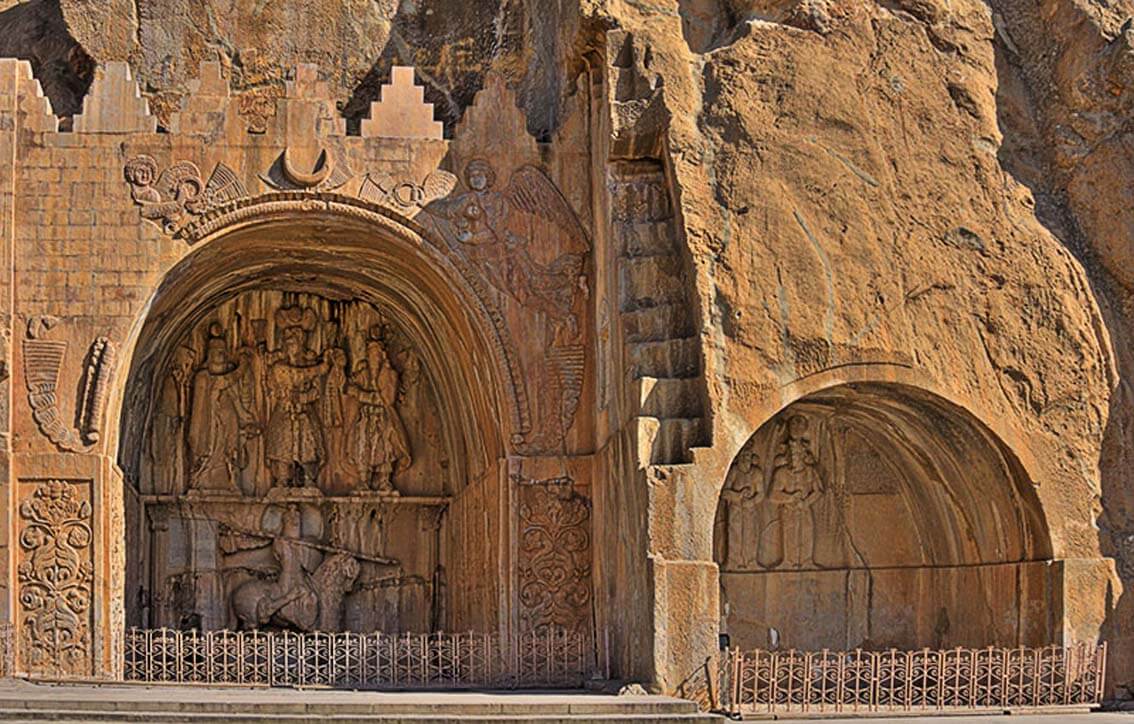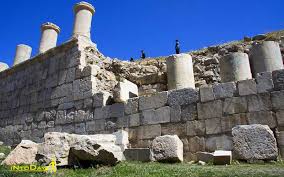Kermanshah
Kermanshah
Kermanshah, and its predominantly Kurdish population, with some Lor is in northwest Iran.
The city, being the capital of the northwest region, served as a supply base for the northern front against the Iraqi assault and was severely hit during the Iran-Iraq war.
Kermanshah is located on the ancient road that connects the Iranian plateau to the Mesopotamian plain. The latter is punctuated by numerous ornamentations and archaeological remains from different periods: Achemenides, Hellenistic, Parthian and Sassanid.
There, in Behistoun, located 20km from Kermanshah, the statue of the Greek hero Hercules who seems to watch over her. On the same rock where this work was carved, appears the proclamation of Darius I written in three languages: Old Persian, Elamite and Akkadian, and which tells us of his illustrious conquests.
Among other vestiges of antiquity, one can find the temple dedicated to the veneration of Artemis, Anahita in the Persian pantheon, 100 km away, in the city of Kangavar.
Nowadays, this route is mainly used by Shia pilgrims from Iran and Iraq.
In Tagh e Bostan we visit the jubilant scene of the Sassanid kings, which offers a style different from the art already known to the Sassanids, the hunting scenes presented as a comic strip with unprecedented realism and incredibly detailed.
The statues with rounded shapes are unheard of in the Sassanid artistic repertoire, and the structure of the bas-reliefs and the halos adorning the busts evoke the influence of Buddhism at that time.
A Tekiey, a place reserved for the commemorative processions of the mourning of Imam Hossein, dating from the 19th century offers a very fine example of Qajar period tiles, very well preserved.
This region is rich and fertile, which favors agriculture. In addition, it is renowned for its traditional cookies.
You need at least 1 day to visit:
Bisotun is located along the ancient trade route linking the Iranian high plateau with Mesopotamia and features remains from the prehistoric times to the Median, Achaemenid, Sassanian, and Ilkhanid periods. The principal monument of this archaeological site is the bas-relief and cuneiform inscription ordered by Darius I, The Great, when he rose to the throne of the Persian Empire, 521 BC. The bas-relief portrays Darius holding a bow, as a sign of sovereignty, and treading on the chest of a figure who lies on his back before him. According to legend, the figure represents Gaumata, the Median Magus and pretender to the throne whose assassination led to Darius’s rise to power. Below and around the bas-reliefs, there are ca. 1,200 lines of inscriptions telling the story of the battles Darius waged in 521-520 BC against the governors who attempted to take apart the Empire founded by Cyrus. The inscription is written in three languages. The oldest is an Elamite text referring to legends describing the king and the rebellions. This is followed by a Babylonian version of similar legends. The last phase of the inscription is particularly important, as it is here that Darius introduced for the first time the Old Persian version of his res gestae (things done). This is the only known monumental text of the Achaemenids to document the re-establishment of the Empire by Darius I. It also bears witness to the interchange of influences in the development of monumental art and writing in the region of the Persian Empire. There are also remains from the Median period (8th to 7th centuries B.C.) as well as from the Achaemenid (6th to 4th centuries B.C.) and post-Achaemenid periods.
Taq-e Bostan means “Arch of the Garden” or “Arch made by stone” is a site with a series of large rock reliefs from the era of the Sassanid Empire of Persia (Iran), carved around the 4th century CE.
This example of Persian Sassanid art has endured almost 1,700 years of wind and rain. Originally, several sources were visible next to and below the reliefs and arches, some of which are now covered. Sources next to the reliefs still feed a large basin in front of the rock. The site has been turned into an archaeological park and a series of late Sassanian and Islamic column capitals have been brought together (some found at Taq Bostan, others at Bisutun and Kermanshah).
The carvings, some of the finest and best-preserved examples of Persian sculpture under the Sassanids, include representations of the investitures of Ardashir II (379–383) and Shapur III (383–388). Like other Sassanid symbols, Taq-e Bostan, and its relief patterns accentuate power, religious tendencies, glory, honor, the vastness of the court, game and fighting spirit, festivity, joy, and rejoicing.
The Anahita Temple is a sites in Kangavar city popularly thought to has been attributed to the ancient deity Anahita.
The remains at Kangavar reveal an edifice that is Hellenistic in character, and yet display Persian architectural designs. The plinth‘s enormous dimensions for example, which measure just over 200m on a side, and its megalithic foundations, which echo Achaemenid stone platforms, “constitute Persian elements”.This is thought to be corroborated by the “two lateral stairways that ascend the massive stone platform recalling Achaemenid traditions”, particularly that of the Apadana Palace at Persepolis.
Tekyeh Moaven al-molk is a Tekyeh and historical place to commemorate the mourning of Hossein the grandson of prophet of Islam. It was built during Qajar era as a Shia mourning site. It is well known for its exclusive tiling, picturing Islamic era Ghazi (warrior), Battle of Karbala and Iranian kings such as Achaemenid kings and Persepolis. It has three main parts: Hussainiya, Zaeynabiya and Abbasiya. Museum of Anthropology of Kermanshah, and Clothes and Jewelry Museum of Kermanshah are located in Abbasiya.




